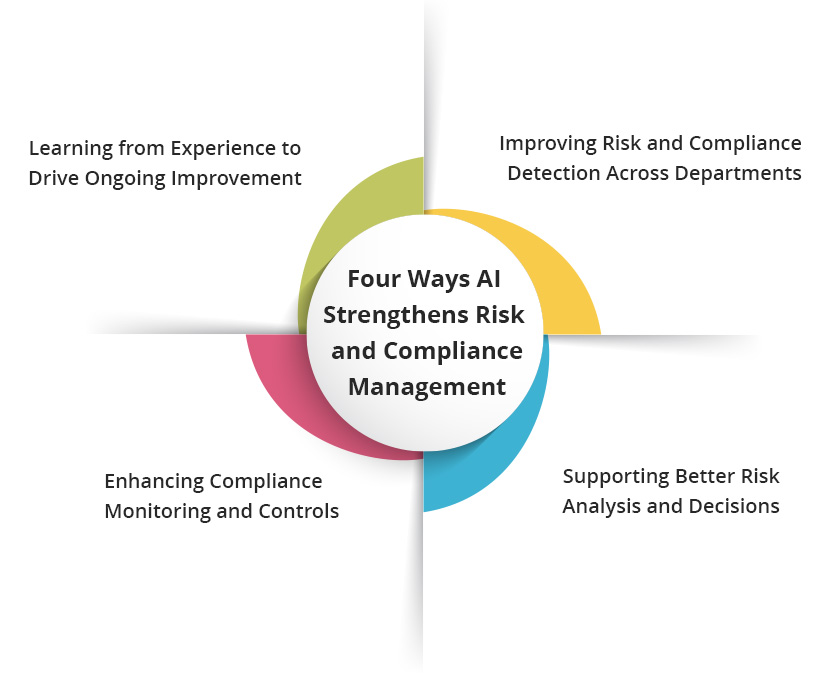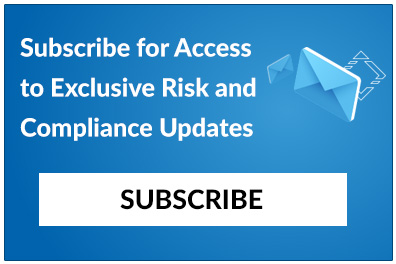Home/ Blog / 4 Powerful Ways AI Is Transforming Risk and Compliance in Financial Services
The financial services industry is navigating an era of accelerated change, mainly due to growing risk complexity and intensifying regulatory demands. Financial institutions deal with interconnected risks spanning cybersecurity, third-party exposure, operational disruption, and evolving compliance requirements. As regulatory scrutiny increases, traditional risk and compliance management approaches are becoming insufficient to meet today’s dynamic expectations.
Generative AI (GenAI) is emerging as a transformational tool for financial institutions seeking to modernize their risk and compliance frameworks. Rather than simply automating tasks, in risk and compliance enables a fundamental shift from manual data collection and fragmented reporting to intelligent, real-time insight and action. Its capabilities go beyond traditional analytics by helping organizations detect risks across departments, analyze interdependencies, learn from historical events, and enhance control effectiveness.
This blog explores four powerful ways AI, particularly GenAI, redefines how financial services organizations identify, analyze, and manage risk while improving compliance operations.
Four Ways AI Strengthens Risk and Compliance Management
Artificial intelligence in financial services strengthens risk and compliance functions in four critical areas:

1. Improving Risk and Compliance Detection Across Departments
One of GenAI’s most transformative aspects is how it improves risk and compliance detection across departments. Generally, risk data is fragmented and isolated in departmental systems and spreadsheets, maintained by finance, compliance, operations, or IT. This siloed structure slows the flow of information and makes it challenging to identify interrelated risks or compliance issues that span multiple domains.
in risk and compliance addresses this by synthesizing data inputs from all areas of the organization, creating a unified and dynamic view of risk and regulations. It draws from structured and unstructured data across systems to reveal patterns, anomalies, and early indicators of trouble that might otherwise go unnoticed. For example, a GenAI risk identification system might highlight that a minor process delay in the supply chain could create downstream risks for customer satisfaction and regulatory service-level agreements. Institutions can act with greater speed and foresight when these cross-functional connections are identified early.
More importantly, GenAI delivers actionable insights. Rather than overwhelming teams with raw data, it interprets relationships and implications of events, enabling faster, more strategic responses. In effect, it breaks down the traditional silos between teams and fosters collaborative, enterprise-level risk awareness.
2. Supporting Better Risk Analysis and Decisions
Once risks have been identified, GenAI in risk and compliance becomes a powerful analytical partner for managers and business unit leaders. It acts as a virtual analyst that can process, summarize, and contextualize vast volumes of data from reports, regulatory updates, incident records, and internal assessments. This enables teams to shift focus from manual data interpretation to deeper analysis and decision-making.
Generative AI in finance supports scenario analysis during risk evaluation by helping teams explore “what if” situations and test the potential impact of different decisions. Based on historical patterns and predictive modeling, it can highlight gaps in controls and reveal emerging risks. For example, in evaluating the effects of new fintech partnerships, GenAI might uncover vulnerabilities related to third-party data handling, flagging them before they pose reputational or regulatory risks.
Additionally, GenAI enables teams to present information more clearly and thoroughly by summarizing complex findings and generating drafts of governance documents. This not only improves decision speed but also enhances trust across the organization.
3. Learning from Experience to Drive Ongoing Improvement
A critical function of any mature risk and compliance program is its ability to learn from past events, whether audit findings, near misses, or regulatory feedback. However, many organizations still rely heavily on individual expertise and informal knowledge-sharing. This creates inconsistency and increases the risk of losing institutional knowledge when key employees leave or change roles.
GenAI in risk and compliance addresses this issue by capturing and structuring the organization’s collective experience. It absorbs insights from historical incident reports, after-action reviews, and audit outcomes to build a shared, searchable knowledge base. These lessons are not static; they evolve as new data is gathered, creating a continually enriched institutional learning system.
As this knowledge base matures, it reduces dependency on individual judgment and increases team consistency. For example, a risk manager in one division can access case studies and response strategies and test mitigation actions from another, ensuring more uniform practices across the enterprise.
Additionally, AI in financial services supports continuous learning by refining its performance over time. As it ingests new examples and receives feedback on its outputs, it becomes better at interpreting data in the context of the organization’s unique risk profile. This feedback loop fosters a culture of learning that bridges both human and AI capabilities, strengthening the institution’s ability to adapt and improve.
4. Enhancing Compliance Monitoring and Controls
Regulatory complexity is growing rapidly, and compliance professionals face mounting pressure to ensure their organizations remain aligned with internal policies and external mandates. GenAI in risk and compliance supports this effort by enhancing compliance monitoring and control effectiveness in several ways.
First, it systematically verifies regulatory obligations, cross-referencing control frameworks against relevant laws, standards, and requirements. If gaps or inconsistencies are found, the system can flag them for immediate attention, enabling preemptive corrections rather than reactive remediation.
Second, GenAI offers real-time tracking of regulatory changes and control status. Instead of manually scanning updates or chasing down owners for status reports, compliance teams receive automated notifications when thresholds are breached or obligations shift. This improves governance and allows compliance officers to take swift, informed action.
Third, GenAI promotes audit readiness and oversight. By maintaining a clear, up-to-date understanding of compliance status and supporting documentation, institutions are better prepared for internal and external audits. It also enhances transparency, making it easier for compliance officers and auditors to demonstrate that controls are documented and effective.
Predict360 Transforms AI in Risk and Compliance into Real Results for Financial Services
Generative AI in risk and compliance is revolutionizing financial businesses by uncovering emerging risks, highlighting compliance gaps, and accelerating data analysis. But the real value of AI doesn’t lie in insight alone; it lies in execution. Too often, organizations identify critical risks or obligations but struggle to act on them due to fragmented systems, siloed teams, and manual workflows. When insights remain trapped in spreadsheets or isolated tools, they fail to drive timely, coordinated responses.
To bridge this gap, companies need a centralized, intelligent risk and compliance platform, one that transforms AI-generated insights into structured actions. Here comes Predict360 Financial Risk and Compliance Management Software. It is an AI-powered, cloud-based platform that transforms organizations’ risk and compliance management by automating tasks and workflows across departments.
Predict360 leverages advanced AI in risk and compliance management to help financial services elevate their programs. By automating key processes and streamlining cross-functional workflows, it empowers financial institutions to identify, mitigate, and optimize risks with greater precision and efficiency. The platform:
- Automates time-consuming tasks such as data collection, analysis, and reporting, freeing up valuable resources.
- Streamlines workflows across departments, enhancing coordination and operational efficiency.
- Enables real-time monitoring of regulatory updates, compliance statuses, and risk indicators, delivering timely alerts and notifications to address potential issues proactively.
- Improves risk identification and assessment, allowing for more accurate evaluation of diverse risk types. Risks can be prioritized by severity and likelihood to support smarter decision-making and effective resource allocation.
Request a Demo
Complete the form below and our business team will be in touch to schedule a product demo.
By clicking ‘SUBMIT’ you agree to our Privacy Policy.



